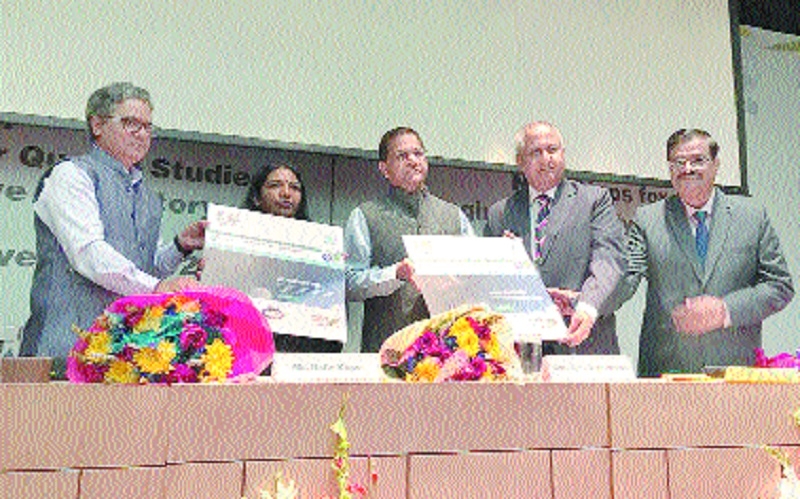NEERI launches India’s first air pollution web repository ‘IndAIR’
| Date :07-Nov-2019 |

S P S Parihar, Chairman of CPCB; Dr Rakesh Kumar, Director, NEERI; Nidhi Khare, Joint Secretary, MoEF&CC; Dr J S Sharma, former Head, Environment Division, ONGC; Dr S K Goyal, Scientist and Head, NEERI, Delhi, at the launch of IndAIR in Delhi on Wednesday.
Staff Reporter :
The repository has research dating from 1905
For long, it is thought that research on air pollution is at a ‘nascent’ stage. To put this notion to rest, Council of Scientific and Industrial Research (CSIR)-National Environmental Engineering Research Institute (NEERI) has launched India’s first web repository, documenting air quality studies done in the last 60 years in the country. The web repository titled Indian Air Quality Interactive Repository (IndAIR) was launched in Delhi on Wednesday. IndAIR archives around 700 scanned materials from pre-Internet era (1950-1999), apart from 1,215 research articles, 170 reports and case studies, 100 cases and over 2,000 statutes to provide the history of air pollution research and legislation in the country. Such a repository on the subject of air pollution is one of the first in the world, said an official familiar with the project. S P S Parihar, Chairman of Central Pollution Control Board (CPCB), launched IndAIR. Dr Rakesh Kumar, Director, NEERI; Nidhi Khare, Joint Secretary, Ministry of Environment, Forests and Climate Change; Dr J S Sharma, former Head, Environment Division, ONGC; Dr S K Goyal, Scientist and Head, NEERI, Delhi Zonal Centre, shared the dais on this occasion.
As per a press statement, S P S Parihar said that the website would provide insights into reasons for air pollution and efforts made to deal with such issues in the past. “It is expected that this will also be a useful platform for the scientific community to share its current work and to exchange ideas,” he said. He appreciated the scientists at NEERI for having been able to highlight the challenges that confronted cities, towns and rural spaces in India currently. Whether it is managing wastewater, treating solid waste and coming up with a solution to the problem of air pollution, their studies have not only helped a great deal in showcasing the issues that exist, but also in throwing light on what can be done to solve them, he observed.
Nidhi Khare said that the Government had taken a number of initiatives to combat air pollution. However, she said, the need of the hour is the collective effort of policy-makers, regulators, scientists/academicians and most importantly public participation to control the episodes of high air pollution. Dr Rakesh Kumar said that though air pollution was one of the most widely deliberated issues, little was known about it in India as far as the statistics or the history was concerned. The general belief has been that not much is being done to tackle the problem.
“We began IndAIR with the intent to document important milestones in the country and make them available to the public. Our hope is that it will not only help the academicians understand the issue better, but will also enable policy makers to frame legislations that encourage development,” he said. It took 22 people and 11 months to give shape to IndAIR. The work included procuring archived material from various institutions across the country, researching studies available beyond the Internet domain, developing the website, interviewing experts across India to comprehend the scope of the history and the project. It received immense support from institutions like National Institute of Science, Communication and Information Resources (NISCAIR), Bhabha Atomic Research Center (BARC), and National Archives of India (NAI). The Energy Resources Institute (TERI); Ministry of Environment, Forest and Climate Change (MoEFCC); and CPCB also partnered with NEERI for the project.
Air pollution was recognised in India in 1905! IndAIR presents a repository of references and research material. Contrary to popular perception that air pollution has been in discussion of late, IndAIR reveals that air pollution was recognised as a subject in India way back in 1905. In 1905, there was Bengal Smoking Nuisance Act. In the next few decades, several legislations followed till the 1970s making it clear to policy-makers and researchers that the issue deliberated scientific research. In 1970, BARC, Central Public Health Engineering Research Institute (CPHERI) (as NEERI was known then), and National Productivity Council (NPC) were assigned the task of fabricating air pollution monitoring equipment. Prior to that, there were dust charts and Ringelmann’s chart, which were used to study the plume from the stack and decide on the levels of pollution.
Also, IndAIR showcases how seminars and events to discuss the ills of air pollution began wholeheartedly in the 1970s, while studies were done as early as the 1950s by various researchers in India. Studies by S C Roy from Meteorological Office detailed on cloud seeding to deal with famine-ridden areas in 1954, while other short-term studies on air quality in Bombay, Delhi, Calcutta, and Kanpur were authored by P K Yennawar, S N Dixit, V L Pampattiwar, V L Dave and J M Arceivala from National Environmental Research Institute, Nagpur. P K Zutshi at BARC authored ‘Perspective on Current Air Pollution Problems’ to create an interest and understanding of the nature, effects and problems of air pollution to help develop a course of action to combat the dire consequences of air pollution in the country. At present, CPCB has about 700 air quality monitoring stations and more than 100 continuous air quality monitoring stations in the country. Those interested may access the repository by logging on to http://www.indair-neeri.res.in/, states a press release.